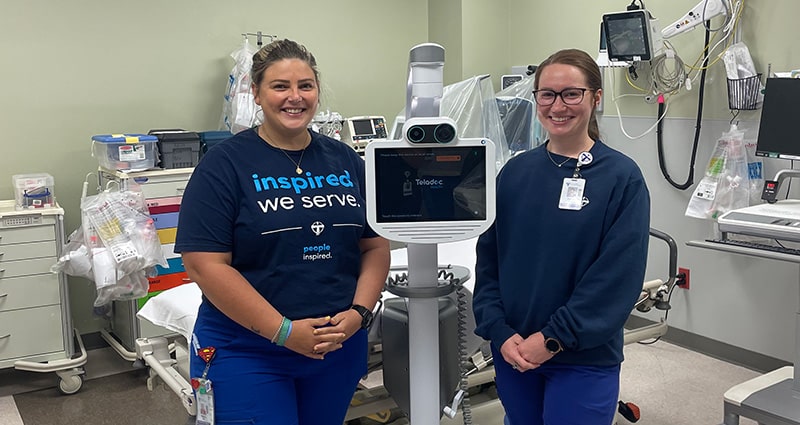At 49, Shannon’s life took an unexpected turn when a stroke struck without warning.
“When I woke up, I was not able to move. I tried to move, but when I got up, I fell,” Shannon says. “My niece had noticed there’s something wrong, so she called 911. They came and took me to the hospital.”
That hospital was Our Lady of the Angels in Bogalusa, just 20 minutes away from where Shannon lives in Franklinton. Her niece’s quick action in calling 911 proved to be crucial. Without prompt access to specialized stroke care, Shannon’s outcome could have been far more dire.
Fast Action and Advanced Care
“When we received the phone call from EMS, we knew immediately that we were going down the stroke route,” says Haylee Schilling, RN, who was part of Shannon’s care team. “We activated our stroke protocol immediately.”
The telestroke program at Our Lady of the Angels connects patients like Shannon through video to neurologists so treatment can begin right away.
“When Shannon arrived, we followed our protocol and quickly got her to CT,” Shilling explains. “This is crucial for the neurologist to evaluate and decide on administering tPA, a clot-busting medication that significantly improves outcomes if given in time; tPA has been a game-changer for stroke patients.”
Shannon’s symptoms were severe, and she scored very high on the National Institutes of Health Stroke Scale. After evaluation, the neurologist prescribed tPA, which stands for tissue plasminogen activator.
Managing Blood Pressure for tPA Administration
Heidi Smith, RN, who leads the stroke care team, recalls, “When Shannon came in, her blood pressure was elevated, which can complicate the administration of tPA. We had to start an infusion to help decrease her blood pressure. As soon as her blood pressure was within the right range, we administered the tPA.”
Smith stayed late to make sure Shannon got the medicine at the right time.
“We managed to administer tPA just a few minutes outside of the window, but it made a significant difference,” Smith says. Shannon’s symptoms began to improve even before she left Our Lady of the Angels to be transferred to a larger hospital.
Without the telestroke program, Shannon would have waited longer for care and possibly experienced greater deficits as she recovered.
Recovery with Faith
Shannon’s recovery from her stroke has been marked by her deep faith and reliance on God. After an initial recovery, Shannon experienced setbacks and was unable to walk. Therapy enabled her to strengthen her legs and be able to walk again.
“I prayed and I worked hard,” she says. “It was hard at first. I picked myself up so I could be here for my child. I kept working on it seven days a week, but what is seven days when you want to get better?”
She’s seen improvements and has had to make significant lifestyle changes since her stroke.
“I’m doing much better,” Shannon says. “I’m talking. I’m not walking fully, but I’m walking. I can do some of the stuff I used to do, but not all of it.”
Shannon has a beautiful outlook on her experience recovering from a stroke at a relatively young age.
“I look at it like it could have been worse,” she says. “I couldn’t do it without God. When I didn’t feel like doing it, I had to pray to get strength to do it.”
Recognize the Symptoms of Stroke
Strokes are a leading cause of death and serious long-term disability in Louisiana and Mississippi. If you think you or a loved one are experiencing a stroke, it’s important to know the signs and symptoms, act quickly and get the right treatment.
A couple days before her stroke, Shannon felt a little disoriented but dismissed it. And during the stroke she wasn’t entirely sure what was happening because it seemed like her symptoms passed before they returned and her niece sprang into action.
Smith underscores the importance of early recognition. “If you notice symptoms like a facial droop, difficulty speaking, balance issues or weakness on one side, don’t ignore them,” she says. “Quick action is crucial.”
Schilling adds, “Shannon’s case highlights how critical it is to have someone there to recognize the symptoms and call for help. Without her niece’s quick action, her outcome could have been much worse.”
The Role of Telestroke in Stroke Care
“The fact that we have that resource is very, very important,” Shilling says of the telestroke program at Angels. “Having a neurologist’s opinion in real-time is crucial for making the best decision for the patient.”
The telestroke program not only aids in immediate care but also facilitates quick transfers for further treatment if needed.
“Even if a patient is outside the window for tPA, they can still have surgery to remove a clot within 24 hours,” Smith explains. “Or if they have a bleed, we can give medicine quickly to stop it and transfer them out promptly. Most of the time, we try to fly them to ensure they get the necessary care without delay.”




